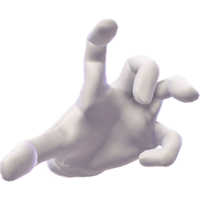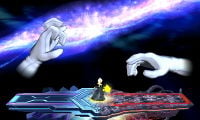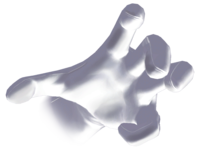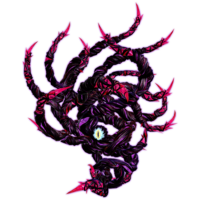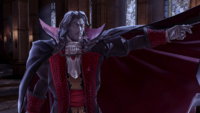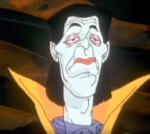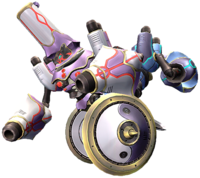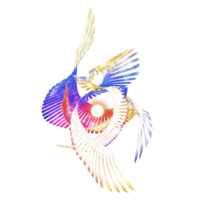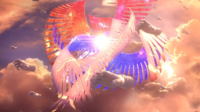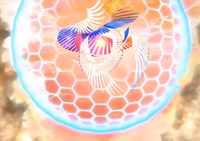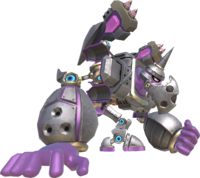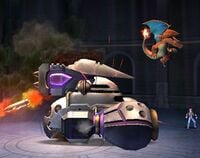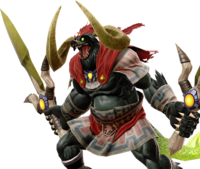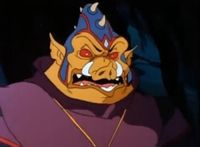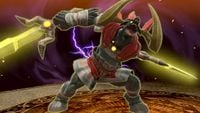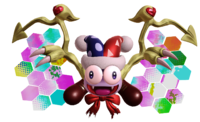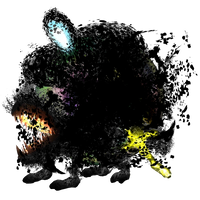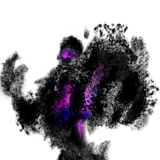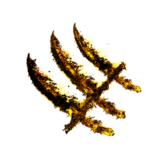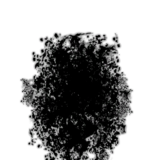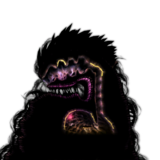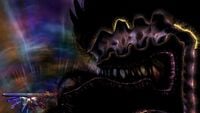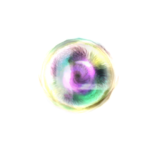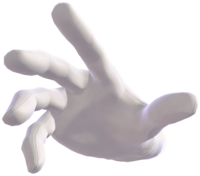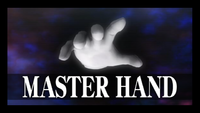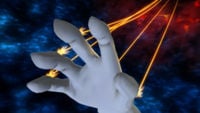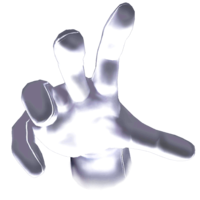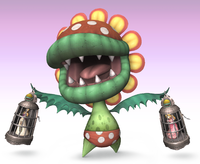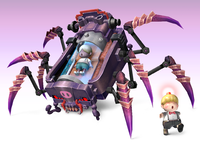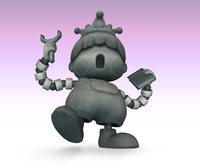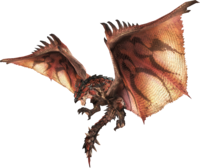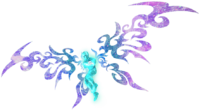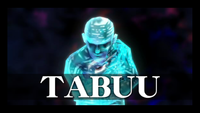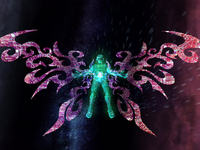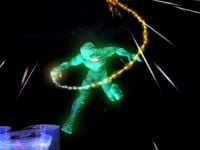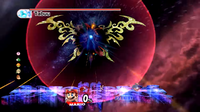List of Super Smash Bros. series bosses
It has been requested that this article be rewritten. Reason: Incorporation of Super Mario bosses with Template:Main
This is a list of Super Smash Bros. series bosses.
Crazy Hand[edit]
- SmashWiki article: Crazy Hand
Crazy Hand is the secondary antagonist in the Super Smash Bros. series, first appearing in Super Smash Bros. Melee. He is the left-handed counterpart of Master Hand, of whom he shares an identical appearance with. Like Master Hand, Crazy Hand is a large, disembodied, gloved hand, but unlike Master Hand, Crazy Hand embodies a being of destruction instead of creation.
Crazy Hand can use more attacks than Master Hand and also attacks more frequently, so fighters are given fewer opportunities to attack Crazy Hand. Many of Crazy Hand's attacks have side effects, such as the Lip's Stick flower.
Crazy Hand is voiced by Dean Harrington (Melee), Pat Cashman (Brawl), and Xander Mobus (3DS / Wii U and Ultimate), who also voiced the announcer of the respective games.
Crazy Hand's laugh in Melee
Crazy Hand's laugh in Brawl
Crazy Hand's laugh in for 3DS / Wii U and Ultimate
Super Smash Bros. Melee[edit]
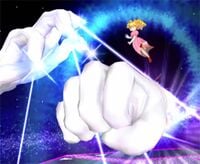
Crazy Hand is one of the main antagonists in Super Smash Bros. Melee, along with Master Hand and Giga Bowser. Crazy Hand will appear alongside Master Hand in a timed match when the player completes Classic mode on Normal, Hard, or Very Hard under ten minutes, and does not use a continue. In addition, Crazy Hand is also fought in the 50th event match alongside Master Hand. This match is not timed.
On Very Hard difficulty, Crazy Hand's drill, rocket punch, jet (only when he attempts to fly into the player), third poke, grab (forward throw), and punch (on grounded players) are all a one-hit KO.
Defeating Crazy Hand in Classic mode earns the player 80000 points, which is mandatory for getting the Diskun trophy.
Super Smash Bros. Brawl[edit]
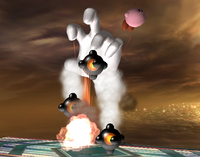
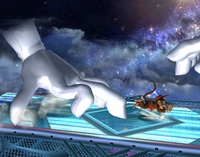
In Super Smash Bros. Brawl, Crazy Hand appears under the same circumstances in Classic mode as he does in Super Smash Bros. Melee, though the only difference is that he appears immediately rather than after depleting Master Hand's HP by half. Though he is absent from The Subspace Emissary, Crazy Hand appears in Boss Battles Mode with the standard Emissary boss health bar.
Unlike in Melee, no bonuses are awarded for defeating Crazy Hand in this game. As a result, defeating Crazy Hand in Classic Mode is not mandatory for completing 100% of Brawl.
Super Smash Bros. for Nintendo 3DS / Wii U[edit]
Crazy Hand retains his role as a final boss in Classic mode in Super Smash Bros. for Nintendo 3DS, along with Master Hand. However, rather than having to clear Classic mode within a certain time, Crazy Hand will appear in battle if the player sets the intensity to 3.0 or higher, and chooses the black path at the end. However, on intensity 8.0 and higher, only the black path will be available, and Crazy Hand must be fought. In battle, both Master Hand and Crazy Hand share their stamina. When the intensity is set to 5.1 or higher, after losing a portion of stamina, Master Hand will be engulfed in flames and exit the battle, while Crazy Hand will transform into the Master Core.
Crazy Hand is also a final boss in Super Smash Bros. for Wii U's Classic mode. However, unlike in the 3DS version, players will be forced to fight Crazy Hand, along with Master Hand, at intensity 3.0 or higher; this also means that at intensities 5.1 and above, Master Core must be fought as well. Also, one of the two Special Orders modes is Crazy Orders, which involves using a pass or spending gold to participate in consecutive battles and racking up rewards in a ten minute timespan. After winning at least one battle, the player can choose to fight Crazy Hand in a stamina match. Depending on how many tickets have been cleared, additional opponents may appear alongside Crazy Hand, including Master Hand. Crazy Hand occasionally drops chests when hit, and when defeated, the player gets to keep all rewards accumulated.
Crazy Hand also has a new move, known as the Void. He rips open some part of the air and can suck the players into a void, which deal damage after the players are launched out. The only ways to avoid the Void are using shield, and doing continuous rolls.
Super Smash Bros. Ultimate[edit]
Crazy Hand reappears in Super Smash Bros. Ultimate, where he returns as a boss in Classic mode, as well as in Adventure Mode: World of Light. In Classic mode, Crazy Hand appears alongside Master Hand if the player reaches Intensity 7.0 or higher, though some fighters are assigned to fight the former alone. In World of Light, Dharkon creates an army of clones of the original Crazy Hand, some of whom create obstacles for the player, and are fought as well. If the player meets the requirements for the game's true ending, Crazy Hand and Master Hand help the player by opening up a hole in space for them to enter, to defeat Galeem's and Dharkon's clones and for the final battle with both entities.
Crazy Hand also appears as an Ace-class Neutral-type primary spirit. It allows three support slots and is obtainable by winning the last battle against Crazy Hand in World of Light. It is among the most powerful spirits in the game.
Names in other languages[edit]
| Language | Name | Meaning |
|---|---|---|
| Japanese | クレイジーハンド Kureijī Hando |
Crazy Hand |
| Chinese | 疯狂之手 (Simplified) 瘋狂之手 (Traditional) Fēngkuáng zhī Shǒu |
Crazy Hand |
| French | Dé-mainiaque |
Pun on "démoniaque" (demoniac) and "main" (hand) |
| German | Crazy Hand |
- |
| Italian | Crazy Hand |
- |
| Portuguese (NOA) | Mãolévola |
Pun on "mão" (hand) and "malévola" (malevolent) |
| Portuguese (NOE) | Mão Maníaca |
Manic Hand |
| Russian | Безумная рука / Безумец Besumnaya ruka / Bezumets |
Crazy Hand / The Crazy |
| Spanish | Crazy Hand |
- |
Dharkon[edit]
- SmashWiki article: Dharkon
Dharkon is one of the two main antagonists of Super Smash Bros. Ultimate's World of Light mode and is the dark counterpart to Galeem. Dharkon's body consists of many spiky dark-purple tentacles formed into a jumbled mass with a single light-blue eyeball in the center. His name is a corruption of the word "darken."
Dharkon first appears after Galeem's first defeat, emerging from a large crack in the sky, along with an army of Crazy Hands. He proceeds to power through Galeem's Master Hand army and takes control of the remaining fighters, creating his own world of darkness. After his first defeat, Dharkon flees to the final world along with Galeem, who wages a war against Dharkon and his Crazy Hand army with his army of Master Hands. In the final world, if only Galeem is defeated, Dharkon enchains Galeem and covers the world in darkness. Mario is seen collapsing, apparently dead, as the screen goes black, before Dharkon's eye appears. In the other bad ending, where only Dharkon is defeated, the world is completely engulfed in light, and Galeem disintegrates Dharkon's body. In the true ending, both Galeem and Dharkon are defeated.
During the final battle between both Galeem and Dharkon, Dharkon attempts to damage players with his tentacles while climbing a vertically scrolling stage. He also spawns more dark versions of the fighters, which players must defeat to progress. Galeem also does this in the second half, except with light versions of fighters.
Dharkon also appears as a Legend spirit alongside Galeem, which both can be obtained by getting the good ending in World of Light. He is tied with Galeem by having the most overall power of spirits in the game. Though the spirit has no slots, he has a unique ability called "Bane of Light," in which fighters take and deal a doubled amount of damage against fighters controlled by light in Adventure mode.
Dharkon makes an additional appearance in Hero's reveal trailer, where he is shown to have created puppet fighters of Marth and Meta Knight.
Battle[edit]
Dharkon uses several attacks during his fights, including creating two large darkness waves that move erratically on the left and right sides of the screen, which players must dodge. Dharkon may also disappear for a moment and reappear as a single tentacle that moves around the stage as well as create two portals and quickly move between both of them, attempting to damage the player. He also may spawn several bombs that will explode, which have an effect similar to the X Bomb. He can also spawn dark versions of the fighters, who fight along with Dharkon, who causes large beams to shoot onto the stage, attempting to damage the player.
Dharkon may also attempt to stab the player with his tendrils, exposing his eye after the last hit. He can also fire a barrage of small energy balls from the top left corner of the screen. He is capable of teleporting around the stage in a similar manner to Master Hand and Crazy Hand. The only part of Dharkon's body that players can damage is his eyeball, which may temporarily be stunned and fall on the stage, allowing players to get a few easy hits. After his health is about halfway depleted, Dharkon becomes angry, his eye turning red, and begins attacking faster.
During the true final battle, if Galeem is stunned, Dharkon forms a mallet out of his tendrils and smashes his counterpart's core. When defeated in this fight, Dharkon unleashes a powerful explosion that deals massive damage to the player and Galeem.
Names in other languages[edit]
| Language | Name | Meaning |
|---|---|---|
| Japanese | ダーズ Dāzu |
Darz; derived from「ダーク」(dāku, dark) |
| Chinese | 达兹 Dázī |
Transliteration of Japanese name |
| Dutch | Dharkon |
|
| French | Sumbra |
From "sombre" (dark) |
| German | Dhars |
Transliteration of Japanese name |
| Italian | Teneber |
From "tenebre" (darkness) with "-er" |
| Korean | 다즈 Dajeu |
Transliteration of Japanese name |
| Russian | Мурак Murak |
From "мрак" (mrak, darkness) |
| Spanish | Lúgubra |
|
Dracula[edit]
- SmashWiki article: Dracula
Count Dracula is the main antagonist from the Castlevania series, based on the character of the same name from the titular 1897 horror novel, Dracula. He appeared in various episodes of Captain N: The Game Master as a minor antagonist and is a boss character in Super Smash Bros. Ultimate.
Captain N: The Game Master[edit]
Dracula is a minor antagonist in Captain N: The Game Master, in which he is referred to as The Count and often acts as a minion of Mother Brain's forces. In "Videolympics", he joins Mother Brain's team with Donkey Kong.
Super Smash Bros. Ultimate[edit]
Dracula appears a boss in Classic Mode and Adventure Mode: World of Light in Super Smash Bros. Ultimate. His appearance in said game is based off the one from Castlevania: Symphony of the Night. Dracula's Castle also appears as a playable stage in-game.
During the battle, he can transform into his form from Castlevania: Rondo of Blood, a demonic bat-like creature with long horns. The characters that fight Dracula at the end of their Classic Mode are Luigi, Pac-Man, Simon Belmont, and Richter Belmont. Sephiroth also faces him in his Classic Mode route, but not as the final boss.
Names in other languages[edit]
| Language | Name | Meaning |
|---|---|---|
| Japanese | ドラキュラ Dorakyura ドラキュラ伯爵 (his full title in Castlevania: Rondo of Blood, where his second form design is taken from in Super Smash Bros. Ultimate) Dorakyura-hakushaku ドラキュラ・ヴラド・ツェペシュ (his full name in Castlevania: Symphony of the Night, where his first form design is taken from in Super Smash Bros. Ultimate) Dorakyura Vurado Tsepeshu |
Dracula Count Dracula Dracula Vlad Tepes, as translated in official English scripts. The character is named after and loosely based on Vlad Ţepeș, one of the rulers of Wallachia, who was believed to have inspired Bram Stoker's original Dracula character. |
| Dutch | Dracula |
- |
| Finnish | Kreivi |
Count |
| French | Dracula |
- |
| German | Dracula |
- |
| Italian | Il conte (Captain N) Dracula |
The Count - |
| Spanish | Drácula |
- |
Duon[edit]
- SmashWiki article: Duon
Duon is a boss in the Subspace Emissary of Super Smash Bros. Brawl. It is a large robot with wheels and two bodies (hence its name, which is derived from the word "duo"): one armed with cannons and the other with blades.
Super Smash Bros. Brawl[edit]
Duon is located atop the Battleship Halberd Bridge. In the game, it is fought by Fox, Falco, Snake, Lucario, Zelda or Sheik, and Peach.
Six Mr. Game & Watches are launched through the glass of the Halberd's control room and land a few feet away from where Zelda, Peach, and Fox stand. They dissolve into Shadow Bugs and quickly reform into the monstrous Duon, which Fox, Zelda, and Peach prepare to battle. Lucario and Snake jump from the control room's window and land behind the three. Falco lands behind the fighters after ejecting from an Arwing as it flies overhead. All the characters work together to defeat Duon. After being defeated, Duon shrinks, and loses all of the shadow bugs that made it so powerful. A lone Mr. Game and Watch trophy lays in its place. With the Mr. Game & Watches gone from the wheel, Meta Knight regains control of the Halberd. Duon later appears in The Great Maze, where it appears at the same area, atop the Halberd's bridge.
Its attacks involve spinning rapidly, firing a barrage of missiles, crushing the player by jumping, and shooting lasers in a circular pattern, amongst other attacks. While Duon fires the missiles, the player can move behind Duon. The missiles may hit Duon, dealing damage to it.
Super Smash Bros. Ultimate[edit]
Duon also appears in Super Smash Bros. Ultimate as an Advanced-class Attack-type primary spirit with two support slots. The spirit can be encountered in the Base sub-world of the Light Realm in World of Light. The spirit's puppet fighters are giant Ice Climbers on the Halberd stage, referencing Duon's battle from Super Smash Bros. Brawl.
Names in other languages[edit]
| Language | Name | Meaning |
|---|---|---|
| Japanese | デュオン Dyuon |
Duon |
| Chinese | 杜昂 Dù'áng |
Duon |
| Dutch | Duon |
- |
| French | Duon |
- |
| German | Duon |
- |
| Italian | Duon |
- |
| Spanish | Duon |
- |
Galeem[edit]
- SmashWiki article: Galeem
Galeem, also known as the Lord of Light,[1] is one of the two main antagonists of Super Smash Bros. Ultimate's World of Light mode, resembling a large sphere of light surrounded by seraph-like wings with shifting colors and patterns on them. His English name is likely a corruption of the word "gleam."
In the opening, Galeem is commanding a horde of Master Hands against the various playable fighters. However, he then absorbs the Master Hands, turning into a black hole, and uses them to unleash a devastating attack, which only Kirby manages to escape from. Everyone else is hit with snaking yellow beams of light, which imprison them within the eponymous World of Light, before the beams then continue outwards and cover the planet, turning everyone else into spirits.
Galeem has a dark counterpart, known as Dharkon, who plans to engulf the universe in darkness and serves as the primary rival to Galeem. At the end of the game, if players defeat either Galeem or Dharkon separately, they receive a bad ending. If Dharkon is defeated, Galeem incinerates his counterpart and engulfs all of reality in light, leaving a blank screen. If Galeem is defeated, Dharkon imprisons him in chains. By balancing light and dark in the final area, however, and enlisting the help of Master Hand and Crazy Hand, both Galeem and Dharkon can be faced in the true final battle.
Galeem attacks the player during the platforming section of the final battle, moving across the screen with two spinning discs made of his wings. He can be repulsed by attacking his core. After the player defeats all of the mode's previous bosses, the player engages in the final phase, where both entities fight each other and the player simultaneously, with them even attacking each other directly if one becomes incapacitated. In the true ending, both Galeem and Dharkon fall into a large body of water and explode, allowing all of the spirits to go free. Once players beat the true boss fight, they earn Legend spirits of both Galeem and Dharkon. Galeem's spirit has no slots, but it comes with a unique ability called "Bane of Darkness," in which damage towards and received from enemies controlled by darkness gets doubled in Adventure mode.
Galeem makes an additional appearance in Sephiroth's reveal trailer, alongside several Master Hands. He is cut in half by Sephiroth as the latter makes his appearance.
Battle[edit]
During his boss fights, Galeem mainly attacks by forming weapons from his wings. He is damaged by attacking his core, which moves around the stage. He may form three, later four, drill-like weapons from his wings and slam them into the ground. He may also create a blue orb of energy and fire it into the center of the stage, where he splits into three or four smaller orbs that home in on the player. Another attack consists of Galeem creating a multitude of lines crisscrossing the screen. Laser beams appear along these lines, damaging the player. Galeem can also create three or four small floating mines that explode in a plus-formation similar to that of an X Bomb. He can split his core into three and shoot a barrage of fireballs at the player. He can also teleport around the stage similarly to Master Hand and Crazy Hand.
When his health is about halfway depleted, Galeem is stunned, his wings disappearing and his core falling onto the ground in the middle of the stage. Following this, Galeem becomes angry, his core glowing more brightly. He is now capable of creating bright blue versions of fighters, which attack the player before exploding after a short time. When he has very little health remaining, Galeem is stunned again.
In the second fight at the end of the game, Galeem has two new attacks. He can now create waves of light on the sides of the screen with a gap between them. The waves have no knockback, but they can deal damage even through shields. He can also create two to four eye-like lights that emit shockwaves across the screen. His blue orb attack now creates more smaller orbs. When Galeem is battled alongside Dharkon, Galeem's wave attack is horizontal and is operated in cooperation with Dharkon's dark waves. Galeem and Dharkon can be harmed by one another's attacks. When Dharkon is stunned, Galeem attacks his counterpart by forming a blade out of his wings and stabbing his eye. Sometimes, both bosses disappear, leaving two puppet fighters each.
When defeated in the final fight, Galeem releases a shockwave of energy that deals significant damage and knockback.
Names in other languages[edit]
| Language | Name | Meaning |
|---|---|---|
| Japanese | キーラ Kīra |
From「きらきら」(kirakira, onomatopoeic term for glistening object) or「煌めく」(kirameku, to gleam), also likely an anagram of "killer"; romanized as "Kiila" |
| Chinese | 吉拉 Jílā |
Transliteration of Japanese name |
| Dutch | Galeem |
- |
| French | Kilaire |
A fusion between the Japanese name and "Luminaire" |
| German | Kyra |
Transliteration of Japanese name |
| Italian | Kiaran |
From the Japanese name and "chiaro" (bright) |
| Korean | 키라 Kila |
Transliteration of Japanese name |
| Russian | Сиян Siyan |
From "сиять" (siyat, to shine) and possibly "-ун" (-un, Russian suffix equivalent to "-er") |
| Spanish | Lúmina |
Latin word for "luminous" |
Galleom[edit]
- SmashWiki article: Galleom
Galleom is a boss that appears in Super Smash Bros. Brawl and Super Smash Bros. Ultimate. It is a purple-skinned ape-like monster in a robotic form. Galleom possesses the ability to "transform" between a futuristic tank form and an upright robot. Its name is a corruption of "galleon", a ship class from the 16th-18th centuries.
Super Smash Bros. Brawl[edit]
Galleom is first fought by Meta Knight, Marth, and Ike. After the battle, Galleom takes a huge leap and lands near to where Wario was once turned into a trophy. However, the floor breaks from the impact of the landing, and Galleom falls into The Ruined Hall. Galleom then sees Lucas and Pokémon Trainer, and fights them. After the second battle, Galleom grabs Lucas and Pokémon Trainer and opens its cranium, revealing a Subspace Bomb. Galleom launches into the air with them having only 15 seconds left, intending to take them with itself to its death.
Lucas uses PK Thunder to break off Galleom's arm, and frees them. Right before they land, they are saved by Meta Knight. Galleom, however, meets its end with the explosion of the Subspace Bomb. Later though, players must fight it for a third time in The Great Maze. Although it was fought two times earlier in the game, players only need to fight it once in the Great Maze.
The Galleom trophy is earned by use of a Trophy Stand. To get the trophy of the tank form of Galleom, the player must clear the Boss Battles game mode on Intense difficulty level.
Super Smash Bros. Ultimate[edit]
Galleom returns in Super Smash Bros. Ultimate in the World of Light mode. It also serves as one of the final bosses in the game's Classic Mode where it is fought by Wolf, R.O.B., Snake, King K. Rool, Dark Pit, and Min Min. It is also fought in Mega Man's and Sephiroth's Classic Mode route, though it is not the final boss.
The Galleom spirit can be earned by defeating Galleom in World of Light. It is an Advanced-class Neutral-type primary spirit that has three support slots and strengthens the user's fist-based attacks.
Galleom also makes a cameo in the Home-Run Contest, where it can be seen flying in space in the background.
Names in other languages[edit]
| Language | Name | Meaning |
|---|---|---|
| Japanese | ガレオム Gareomu |
Galleom |
| Chinese | 加雷欧姆 (Simplified) 加雷歐姆 (Traditional) Jiā léi ōu mǔ |
Galleom |
| Dutch | Galleom |
- |
| French | Galéon |
|
| German | Galleom |
- |
| Italian | Galleom |
- |
| Spanish | Galleom |
- |
Ganon[edit]
- SmashWiki article: Ganon
Ganon, also referred to as Beast Ganon or Ganon, The Demon King, is the beast form of Ganondorf and the primary antagonist of the The Legend of Zelda series. He made his first appearance in the Nintendo Entertainment System title, The Legend of Zelda. Ganon is the archenemy of Princess Zelda and Link, and is the king of darkness. Ganon's beast form has seen many visual changes throughout the series, but is always resembling some kind of boar or warthog. The beast form of Ganondorf has appeared in more installments of The Legend of Zelda series than his Gerudo form, and is frequently fought as the final boss.
The Legend of Zelda[edit]
In the original The Legend of Zelda television series produced by DIC Entertainment, Ganon starred as the primary antagonist. His goal was to steal the Triforce of Wisdom from Link and Princess Zelda. He was portrayed by the late Len Carlson.
Captain N: The Game Master[edit]
Ganon appeared in the episode "Quest for the Potion of Power" of Captain N: The Game Master. He borrows his appearance and personality from The Legend of Zelda TV series, and is also portrayed by Len Carlson.
Super Smash Bros. Brawl[edit]
- Main article: Ganondorf § Beast Ganon
Ganon appears as Ganondorf's Final Smash in Super Smash Bros. Brawl, where he is called "Beast Ganon." He is based on his beast form from The Legend of Zelda: Twilight Princess.
Super Smash Bros. for Nintendo 3DS / Wii U[edit]
Ganon returns as Ganondorf's Final Smash in both Super Smash Bros. for Nintendo 3DS and Super Smash Bros. for Wii U, with the same look and name as the previous installment.
Super Smash Bros. Ultimate[edit]
Though Ganon returns as Ganondorf's Final Smash in Super Smash Bros. Ultimate, this time he is based on his appearance from The Legend of Zelda: Ocarina of Time. He is also called "Ganon, The Demon King" in this installment, and functions slightly differently from Ganondorf's previous Final Smash. In addition, Ganon appears as a boss in both Classic Mode and in the Adventure Mode: World of Light. For Classic Mode, he is fought as the final boss for Link, Young Link, Toon Link, and Zelda. Sephiroth also fights Ganon in his Classic Mode route as a non-final boss.
Nintendo Land[edit]
Ganon is fought as a boss in Nintendo Land in the The Legend of Zelda: Battle Quest attraction.
Names in other languages[edit]
| Language | Name | Meaning |
|---|---|---|
| Japanese | ガノン Ganon |
Ganon |
| Chinese (simplified) | 盖侬 Gàinóng |
Ganon |
| Chinese (traditional) | 加儂 Jiānóng |
Ganon |
| Spanish | Ganon |
- |
Marx[edit]
- SmashWiki article: Marx
Marx is a character from the Kirby series who made his debut as the final boss of the Milky Way Wishes game in Kirby Super Star. He appears as a boss in Super Smash Bros. Ultimate, serving as the final enemy in the Classic Mode runs of Kirby, Rosalina and Luma, and Inkling. Sephiroth also fights Marx in his Classic Mode route, but not as a final boss. He also appears as a boss in the adventure mode, World of Light, where he serves under Dharkon. A Mii hat based on Marx exists in Super Smash Bros. Ultimate, unlockable for 450 G, that Mii Fighters can don.
Prior to his Super Smash Bros. Ultimate appearance, his boss battle theme from Kirby Super Star ("Vs. Marx") appeared in an arranged form in Super Smash Bros. Brawl and Super Smash Bros. for Wii U. It can be played on Halberd. "Vs. Marx" returns in Super Smash Bros. Ultimate, being a selectable music track for any Kirby stage, and is featured in Marx's boss battle (except for in the Classic Mode run of Inkling).
Tabuu, the final boss in the Subspace Emissary mode in Super Smash Bros. Brawl, shares a similar moveset to Marx.
Names in other languages[edit]
| Language | Name | Meaning |
|---|---|---|
| Japanese | マルク Maruku |
An uncommon spelling of the name "Mark", may also incorporate「魔」(ma, demon); rendered "Marx" in official romanizations |
| Chinese (simplified) | 魔噜酷 Mó lū kù |
Transcription of the Japanese name. The character 魔 (pronounced as Ma in Japanese), while having many meanings, here means "demon" considering Marx's characteristics. The character 酷 can mean "cruel" or "cool" in different contexts |
| Chinese (traditional) | 魔嚕酷 Mó lū kù |
Transcription of the Japanese name. The character 魔 (pronounced as Ma in Japanese), while having many meanings, here means "demon" considering Marx's characteristics. The character 酷 can mean "cruel" or "cool" in different contexts. |
| Dutch | Marx |
- |
| French | Max |
- |
| German | Max |
- |
| Italian | Mark |
- |
| Korean | 마르크 Maleukeu |
Transcription of the Japanese name |
| Portuguese | Marx |
- |
| Russian | Маркс Marks |
Marx |
| Spanish | Marx |
- |
Master Core[edit]
- SmashWiki article: Master Core
Master Core is the final boss of the Classic mode in Super Smash Bros. for Nintendo 3DS and Super Smash Bros. for Wii U.
In Super Smash Bros. for Nintendo 3DS, Master Core can only be fought on intensity levels 5.1 and higher, but only if the player takes the black route to face Master Hand and Crazy Hand together; Master Core will not appear if the player is only fighting against Master Hand. When playing on intensity 8.0 or higher, however, the player can only take the black route, making the Master Core battle inevitable.
In Super Smash Bros. for Wii U, the player does not have the option to avoid fighting Master Hand and Crazy Hand together, and as such, on intensities 5.1 and higher, Master Core must be fought.
During the final battle between the player and both Master Hand and Crazy Hand, once Master Hand loses a portion of his stamina, Crazy Hand leaves, and Master Hand's glove rips open and reveals Master Core.
Master Core is hidden under a mass of black particles called Swarm, that take on a variety of different transformations and forms during the battle, each form doing a different attack. The forms that Master Core uses include a humanoid known as Master Giant, a monster known as Master Beast, a group of swords known as Master Edges (Master Sabres in the British English version), a clone of the fighter known as Master Shadow, and the true Master Core itself.
The initial form of Master Core depends on the intensity level. By setting the intensity to 7.5 or higher (7.0 or higher in Super Smash Bros. for Wii U), Master Core will start out in its Master Giant form. Setting the intensity to 6.0-7.4 (6.0-6.9 in Super Smash Bros. for Wii U) will have Master Core start as Master Beast. Finally, setting the intensity to 5.1-5.9 will have Master Core start as Master Edges.
Master Shadow is always fought after Master Edges, and it is a clone of the fighter, down to the fighter's customizations, which include any active equipment and custom specials. The clone begins as being larger than the fighter, but it shrinks as it takes damage. The player either has to KO Master Shadow or fully deplete its stamina to defeat it.
In the Wii U version, an exclusive form known as Master Fortress appears after beating the first four forms, but only when the intensity level is set to 8.0 or higher. The player is given 3 extra minutes, along with a Heart Container, and must travel though a maze made from the Swarm to destroy various weak points. Master Fortress only appears in Solo mode, however, so it is never encountered at all in Group mode.
Once the Swarm is defeated, the black mass disappears, and reveals Master Core's true form, a colorful ball resembling a Smash Ball. In this state, Master Core is completely vulnerable, though if it is not destroyed within 45 seconds, it rises and starts to attack the player by emitting waves that instantly KO the player if hit before it automatically self-destructs.[2]
In Master Core's battle theme, a series of beeps play, which spell out its name when translated from Morse code.
Master Giant[edit]
If the intensity of Classic mode is 7.0 (7.5 for the 3DS version) or above, Master Giant is the first form of Master Core. It has a wide variety of attacks, including the ability to physically lift up the stage in an attempt to hurt the player. When it takes enough damage, it loses its head, disabling some of its attacks.
Master Beast[edit]
Unlike the Master Giant, the Master Beast stays on-stage for most of its attack duration. It will appear first from intensities 6.0 to 6.9 (6.0 to 7.4 on the 3DS version), otherwise it will follow Master Giant at higher intensities, and not appear at all on lower intensities.
Master Edges[edit]
If the intensity is set from 5.1 to 5.9 in either of the two versions of the game, Master Edges is the first form of the Master Core that appears. All of the attacks from this form involve swinging the swords at the player.
Master Shadow[edit]
This form always follows Master Edges, no matter what the intensity is. The Master Shadow takes the form of the player, but bigger. It will copy everything right down to the custom moves and abilities. This form starts bigger than the character and gradually shrinks as it is attacked. When it is hit off the blast line or runs out of stamina, it will always transform into the true Master Core.
However, in Super Smash Bros. for Wii U, if the player is playing Solo Classic mode at intensity 8.0 or higher, he/she will be required to defeat Master Fortress next.
It should also be noted that in Group mode, Master Shadow will only copy the first player; the second player will never be copied.
Super Smash Bros. for Nintendo 3DS (Robin)
Master Fortress[edit]
This form appears at intensities 8.0 or higher on the Wii U version, but only in Solo mode; this phase gets skipped completely in Group mode. When this appears, the player must trek through the fortress to destroy 4 cores. After destroying 2, the player is automatically ejected and must reenter. Inside the fortress are shadowy foes hoping to impede the player's progress, and danger zones much like the ones in The Great Cave Offensive. The danger zones will automatically KO above 100%.
Master Core[edit]
If Master Shadow is defeated, the true Master Core will appear. It will not attack for most of the time. However, if it stays idle long enough, it will rise and attack with five waves, similar to Tabuu's Off-Waves, that automatically KO the player if they hit before it self-destructs.
In Super Smash Bros. for Wii U, if the player is playing Solo Classic mode at intensity 8.0 or higher, the true Master Core will appear after Master Fortress is defeated.
Names in other languages[edit]
- Swarm
| Language | Name | Meaning |
|---|---|---|
| Japanese | スウォーム Suwōmu |
Swarm |
- Master Giant
| Language | Name | Meaning |
|---|---|---|
| Japanese | マスタージャイアント Masutā Jaianto |
Master Giant |
| Dutch | Master Giant |
- |
| French | Colosse suprême |
Supreme Colossus |
| German | Master Giant |
- |
| Italian | Master Colosso |
Master Colossus |
| Spanish | Coloso Supremo |
Supreme Colossus |
- Master Beast
| Language | Name | Meaning |
|---|---|---|
| Japanese | マスタービースト Masutā Bīsuto |
Master Beast |
| Dutch | Master Beast |
- |
| French | Bête suprême |
Supreme Beast |
| German | Master Beast |
- |
| Italian | Master Belva |
|
| Spanish | Bestia Suprema |
Supreme Beast |
- Master Edges
| Language | Name | Meaning |
|---|---|---|
| Japanese | マスターエッジズ Masutā Ejjizu |
Master Edges |
| Dutch | Master Sabres |
- |
| French | Lames suprême |
Supreme Blades |
| German | Master Sabres |
- |
| Italian | Master Lame |
Master Blades |
| Spanish | Espadas Supremas |
Supreme Swords |
- Master Core
| Language | Name | Meaning |
|---|---|---|
| Japanese | マスターコア Masutā Koa |
Master Core |
| Chinese (simplified) | 大师之核 Dàshī zhī Hé |
Master Core |
| Chinese (traditional) | 大師之核 Dàshī zhī Hé |
Master Core |
| Dutch | Master Core |
- |
| French | Créa-Main suprême |
Supreme Master Hand |
| German | Meister Core |
Master Core |
| Italian | Master Core |
- |
| Korean | 마스터 코어 Maseuteo Ko'eo |
Master Core |
| Portuguese | Núcleo Mestre |
Master Core |
| Russian | Главное ядро Glavnoye Yadro |
Main Core |
| Spanish | Master Core |
- |
Master Hand[edit]
- SmashWiki article: Master Hand
Master Hand is the main antagonist and one of the bosses of the Super Smash Bros. series. He is a large, disembodied, right glove who appears in every Super Smash Bros. game, and he first appears in Super Smash Bros.
Master Hand is voiced by the announcer of each game in the series; Jeff Manning in the original, Dean Harrington in Super Smash Bros. Melee, Pat Cashman in Super Smash Bros. Brawl, and Xander Mobus in Super Smash Bros. for Nintendo 3DS / Wii U and Super Smash Bros. Ultimate.
Master Hand's laugh in Super Smash Bros.
Master Hand's laugh in Melee
Master Hand's laugh in Brawl
Master Hand's laugh in for 3DS / Wii U and Ultimate
Super Smash Bros.[edit]
In Super Smash Bros., after a character has defeated every challenger in 1P Game, they are transported to a battlefield known as "Final Destination", where they battle Master Hand. After defeating him, players revert to their doll state.
Master Hand also briefly appears in the opening, where he brings out dolls representing the various playable characters as well as dioramas representing various stages and then snaps his fingers upon counting down to bring them to life.
Super Smash Bros. Melee[edit]
Master Hand reappears in Super Smash Bros. Melee as the embodiment of creation. In Classic mode, the battle against Master Hand in this game is nearly identical to that of the original Super Smash Bros.; after defeating all opposition, the player faces Master Hand in Final Destination. If the player clears all stages on the Normal difficulty or higher within 10 minutes without using a continue, Crazy Hand appears once Master Hand has lost half of his HP. Once defeated, Master Hand falls back into the void of Final Destination as the screen fades to white. The player reverts into a trophy, appearing among the trophies of others who have defeated Master Hand.
Master Hand and Crazy Hand also appear in Event 50: Final Destination Match, where the player must battle the duo with 300 HP each.
There is a glitch that allows the player to play as Master Hand through use of the third GameCube controller port.
Super Smash Bros. Brawl[edit]
In Super Smash Bros. Brawl, Master Hand is featured as a boss in both Classic and Boss Battles modes. Crazy Hand joins him under the same circumstances as in Super Smash Bros. Melee, but unlike the previous game, Crazy Hand appears immediately alongside Master Hand when the battle begins. Master Hand plays a brief role in Adventure Mode: The Subspace Emissary, but despite this, he is not fought as a boss in the mode.
In The Subspace Emissary's storyline, Master Hand makes his debut as the leader of the Subspace Army, commanding Ganondorf, Bowser, and Wario. However, near the end, it is discovered that Master Hand is being controlled by Tabuu via the chains of light in order to trick Ganondorf, Bowser, and Wario into drawing the entire world into Subspace. Angered, Ganondorf attempts to attack Tabuu, but he is blocked by a force field and turned into a trophy upon smashing into Master Hand. This severs the chains holding Master Hand, which tries to fight Tabuu but is knocked to the ground by the force field, where he lies unconscious for the remainder of the mode. When Master Hand is knocked out, he does not turn into a trophy as everyone else does.
Super Smash Bros. for Nintendo 3DS[edit]
Master Hand returns again in Super Smash Bros. for Nintendo 3DS, as the final opponent in Classic mode. At intensity level 3.0 to 7.9, the player will have the option to fight either Master Hand alone or together with Crazy Hand. At 8.0, the player is forced to fight Master Hand with Crazy Hand.
At 5.1 and above, if the player faces both Master Hand and Crazy Hand, after enough damage is dealt, Crazy Hand will be engulfed in purple flames and exit the battle, while Master Hand begins to alter and faces the player as Master Core.
Super Smash Bros. for Wii U[edit]
Master Hand also appears in Super Smash Bros. for Wii U with a new mode called Master Orders and may also appear in Crazy Orders if the player clears a certain amount of tickets before facing Crazy Hand. Much like in the 3DS version, he is the final boss of Classic mode and can transform into Master Core.
Super Smash Bros. Ultimate[edit]
Master Hand reappears in Super Smash Bros. Ultimate as a boss in both Classic Mode and Adventure Mode: World of Light. For the first time since the first Super Smash Bros., Master Hand can face his. In World of Light, an army of clones of the original Master Hand serve under the villain Galeem. When the player fulfills all requirements for the game's true ending, the original Master Hand and Crazy Hand open a giant rift in the sky, which the former enters.
For the first time, Master Hand is playable through normal means, as he is pitted in a Mob Smash-esque match against 50 light and dark false characters.
Master Hand also appears as an Ace-class Neutral-type primary spirit. It allows three support slots and is obtainable by winning the last battle against Master Hand in World of Light. It is among the most powerful spirits in the game.
Names in other languages[edit]
| Language | Name | Meaning |
|---|---|---|
| Japanese | マスターハンド Masutā Hando |
Master Hand |
| Chinese | 大师之手 (Simplified) 大師之手 (Traditional) Dàshī zhī Shǒu |
Master Hand |
| French | Créa-Main |
Creat(or) Hand |
| German | Meisterhand |
Master Hand |
| Italian | Master Hand |
- |
| Korean | 마스터 핸드 Maseuteo Haendeu |
Master Hand |
| Portuguese (NOA) | Mãomestre |
"Mão" (hand) + "mestre" (master) |
| Portuguese (NOE) | Mão Mestra |
Master Hand |
| Russian | Главная рука / Глава Glavnaya ruka / Glava |
Main Hand / The Head |
| Spanish | Master Hand |
- |
Petey Piranha[edit]
- Main article: Petey Piranha
Petey Piranha is an overgrown Piranha Plant character from Super Mario Sunshine. He is the first boss of Super Smash Bros. Brawl.
Porky[edit]
- SmashWiki article: Porky Minch
Porky Minch, originally localized as Pokey, is a character from the EarthBound (Mother) series. He is the secondary antagonist in EarthBound, and is the main antagonist in Mother 3. Porky appears as a boss in Super Smash Bros. Brawl in his spider-bed mech. In The Subspace Emissary, he fights Ness and Lucas and later appears in The Great Maze. His theme for Brawl was first revealed in the Smash Bros. DOJO!!. Several depictions of Porky as a kid appear in the background of the New Pork City, along with his statue. A variation of His Highness' Theme is among the playable tracks in New Pork City.
Though Nintendo of America localised his name as "Pokey" in EarthBound, "Porky" was used in his subsequent appearances in the Super Smash Bros. series. His Japanese name, 「ポーキー」 (Pōkī), can be interpreted as either, but with Mother 3's heavier "pig" themes, "Porky" is believed to be the intended name.[3]
When Lucas walks alone in The Ruined Zoo, a giant statue of Porky appears and begins chasing him through the zoo, attempting to crush him. At the end of the scene, Lucas gets his leg stuck under a root and is about to be hit by the statue, when Ness appears to Lucas's rescue, destroying the statue by using PK Thunder and PK Flash. It reveals Porky inside his spider-like bed machine, and the boys battle him. Ness and Lucas defeat Porky and destroy the machine.
Names in other languages[edit]
| Language | Name | Meaning |
|---|---|---|
| Japanese | ポーキー・ミンチ Pōkī Minchi |
Porky/Pokey Minch |
| French | Porky |
- |
| German | Porky |
- |
| Italian | Porky |
- |
| Spanish | Porky |
- |
Porky Statue[edit]
- SmashWiki article: Porky Statue
The Porky Statue (referred to as The Pig King Statue on the official website)[4] is an optional boss that can be fought in New Pork City in Mother 3. The statue is the most powerful enemy in the game, with 100,000,000 HP and taking only 1 damage from attacks, but it can be defeated using either a New Year's Eve bomb or PK Flash Ω. The Porky Statue also appears in Super Smash Bros. Brawl. Although the official website lists it as a boss, it is not actually counted as a boss in the game.
In the Subspace Emissary, Lucas is in The Ruined Zoo, but after he sees the statue, he runs away. Lucas must travel through the zoo avoiding the Porky Statue. However, soon, he trips over, and just when he thinks it is over, Ness comes and uses his PK Thunder and PK Flash to destroy the large statue, but once destroyed, Porky appears and must be fought. On the hardest difficulty, the Porky Statue moves much quicker.
Aside from the Subspace Emissary, the Porky Statue also has a trophy, which is unlocked by beating Boss Battles on the Very Hard difficulty as the statue cannot be captured with a Trophy Stand in the Subspace Emissary, given that it is invincible and functions as a stage hazard and not an enemy in the level. It is also seen in the background of the New Pork City stage in Super Smash Bros. Brawl and Super Smash Bros. Ultimate.
Names in other languages[edit]
| Language | Name | Meaning |
|---|---|---|
| Japanese | キングのぞう Kingu no Zō |
King Statue |
| French | Statue de Porky la Statue du Roi Pokey[6] |
Porky Statue King Pokey Statue |
| German | Porky-Statue |
Porky Statue |
| Italian | Statua di Porky |
Porky Statue |
| Spanish | Estatua de Porky[5] |
Porky Statue |
Rathalos[edit]
- SmashWiki article: Rathalos
A Rathalos is a type of flying wyvern from the Monster Hunter series of games produced by Capcom.
Super Smash Bros. for Nintendo 3DS / Super Smash Bros. for Wii U[edit]
Super Smash Bros. for Nintendo 3DS and Super Smash Bros. for Wii U feature a downloadable outfit and headgear based on the Rathalos for the Mii Fighter. The outfit is titled Rathalos Mail, and the headgear is called Rathalos Helm. It was released for Wave 4 of the Mii costumes DLC.
Super Smash Bros. Ultimate[edit]
Rathalos appears in Super Smash Bros. Ultimate, both as an Assist Trophy and as a boss in both Classic Mode and the World of Light, the first to appear as both. He is one of the few third-party Assist Trophies without any playable fighters from their home series, with the others being Akira, Bomberman, and Shovel Knight.
As an Assist Trophy, he can strike the opponent with his claws or breathe fire onto the stage. When he roars, nearby fighters may be stunned. In the boss fight for Rathalos, the player fights him on a flat plains stage resembling the Ancestral Steppe from the Monster Hunter series. He is fought in the final round in the Classic Mode routes for Yoshi, Marth, Duck Hunt, and Piranha Plant. He is also fought in the Classic Mode route for Bowser, Hero, and Sephiroth, albeit before the final round (with Mario and Metal Mario for the final battle for Bowser, and with Robin and a giant Charizard for the final battle for Hero, while Sephiroth's route is akin to a boss rush, with Rathalos as the first opponent). During the boss fight, Rathalos can use all of its attacks from his Assist Trophy form (with its claws also dealing poison damage), while also being able to ram the player, swing its tail at them, and fly into them from the background. At certain points, Rathalos may retreat to the background and unleash massive fireballs which will carpet the ground on fire for a few seconds. Although it can be attacked anywhere at any moment when it is faced head on, the most effective method to fight Rathalos is by immobilizing it with items like Pitfalls and Deku Nuts, which can appear either randomly or by striking its tail.
The Rathalos-based outfit for the Mii Swordfighter is also available as downloadable content, having been released in the 9th wave of Mii costumes alongside Pyra and Mythra.
Names in other languages[edit]
| Language | Name | Meaning |
|---|---|---|
| Japanese | リオレウス Rioreusu |
Officially romanized as "Liolæus" |
| Chinese (simplified) | 雄火龙 Xiónghuǒlóng |
Male Fire Dragon |
| Chinese (traditional) | 雄火龍 Xiónghuǒlóng |
Male Fire Dragon |
| Spanish | Rathalos |
- |
Rayquaza[edit]
- SmashWiki article: Rayquaza
Rayquaza is a Legendary Dragon/Flying-type Pokémon from the Pokémon series. It is the mascot of the game Pokémon Emerald. It appears in the Subspace Emissary of Super Smash Bros. Brawl.
In Subspace Emissary, it suddenly emerges from a lake after hearing Diddy Kong, who had been looking at the nearly destroyed Arwing nearby. It attacks the Arwing with an energy ball and grabs Diddy Kong. Diddy screams for help, so Fox McCloud, who manages to escape the damaged Arwing, leaps from it and breaks Diddy free of Rayquaza's grasp using Fox Illusion. Rayquaza, furious, launches another energy ball at Fox, who deflects it back at Rayquaza with his Reflector, causing it to fall back into the lake.
Fox and Diddy engage in a fight with Rayquaza, resulting in the second main boss fight of the Subspace Emissary. Some of its attacks involve burrowing into the ground and then bursting upwards. It also flies with great speed horizontally over the stage and sometimes drops a lightning bolt. The player can defeat it by attacking it around the head.
Although Rayquaza does not appear to have any connections with the Subspace Army, it is fought again in The Great Maze. Rayquaza also appears as both a trophy and a sticker, making it the only Pokémon that is neither playable nor summoned from a Poké Ball to have its own sticker.
Rayquaza also appears in Super Smash Bros. for Wii U and Super Smash Bros. Ultimate as a hazard on the stage Kalos Pokémon League. It sometimes appears in the Dragon-type chamber, where it periodically flies from one side of the screen to another, damaging anyone that it comes into contact with. It also appears a trophy in Super Smash Bros. for Wii U and as a spirit in Super Smash Bros. Ultimate.
Names in other languages[edit]
| Language | Name | Meaning |
|---|---|---|
| Japanese | レックウザ Rekkūza |
A transliteration of「烈空座」(means "the one in the violent sky") |
| Chinese | 烈空坐 Lièkōngzuò |
Same as the Japanese name |
| Korean | 레쿠쟈 Rekujya |
Transliteration from Japanese name |
| Russian | Райкваза Raykvaza |
Same as the Japanese and English name |
| Spanish | Rayquaza |
- |
Tabuu[edit]
- SmashWiki article: Tabuu
Tabuu is the main antagonist and the final boss of the Subspace Emissary mode of Super Smash Bros. Brawl. He is a transparent humanoid figure, with a pair of red eyes, a pair of wings in an intricate pattern which only manifest for his Off Wave attack, and a strange object inside of him. Tabuu is the "embodiment of Subspace"[7] and created the Subspace Army. His name is a corruption of the word "taboo", which means unacceptable or improper by society's terms. The spelling of his name is derived from a katakana transcription of the word, romanized for English language releases.
Super Smash Bros. Brawl[edit]
Tabuu is the embodiment of Subspace. Observing the World of Trophies, he has the desire to cut the world into pieces and bring it into Subspace. However, because he cannot leave Subspace, he is forced to form an army in order to do this. After studying the world and its inhabitants, Tabuu takes control of Master Hand, the master of the world, and using Master Hand recruits Bowser, Wario, and Ganondorf. He also notes the peculiar structure of Mr. Game & Watch, and uses him to create Shadow Bugs, which form the soldiers for the Subspace Army.
Tabuu also takes notice of Meta Knight's ship, the Halberd, to use as transportation for his army, and is successfully able to attack and capture the ship. In addition, he learns of the advanced technology on the Isle of Ancients and conquers the island, using the Robots to build weapons such as Subspace Bombs in order to take parts of the world into Subspace, the Master Robot joining him in the process, turning into the Ancient Minister, serving as a deployer for the immensely powerful Subspace Bombs.[7]
The Subspace Emissary[edit]
After suffering a humiliating defeat, Ganondorf and Bowser enter Subspace to seek out Master Hand. Planning to take control of the army, Ganondorf betrays Bowser before approaching Master Hand and bowing before him. Just as Ganondorf prepares to attack Master Hand, Tabuu reveals himself. Ganondorf tries to free Master Hand by attacking Tabuu, but he easily overpowers Ganondorf, turning him into a trophy with a single attack. Ganondorf falls on Master Hand with enough force to sever Tabuu's strings of light, freeing Master Hand. The weakened Master Hand attempts to destroy Tabuu, but Tabuu easily reflects his attack, stunning Master Hand.
The heroes later arrive and confront Tabuu, who spreads his wings and releases his ultimate attack, the Off Waves, instantly transforming every fighter to their trophy form. He then puts the pieces of the world taken from the World of Trophies to create The Great Maze. However, Luigi, King Dedede, and Ness return back to their original states thanks to the brooches Dedede had invented. The three travel to Subspace and return the heroes to their original forms.
After making their way through the Great Maze, the heroes arrive at Tabuu's lair for the final showdown. Tabuu prepares to use his Off Waves again, but Sonic the Hedgehog appears and attacks Tabuu, shattering his wings and preventing him from transforming the group into trophies. The heroes then face Tabuu in the final battle. After he is defeated, all the pieces of the world taken into subspace and all the characters are returned to their proper locations.
Super Smash Bros. Ultimate[edit]
Tabuu appears as a Legend-class Neutral-type primary spirit in Super Smash Bros. Ultimate, with new artwork. It has three support slots and can be used on Ness or Lucas to increase their PSI attacks; any fighter can otherwise be equipped with the spirit to increase their power, being among the most powerful spirits in the game. The spirit can be encountered on the Mysterious Dimension sub-world of the Dark Realm in World of Light. Its puppet fighter is a Metal Bayonetta fought on the Final Destination stage.
Attacks[edit]
- Off Waves[8] (Japanese: OFF波動 Ofu Hadō): During this attack, Tabuu appears in the background and opens up his wings which proceeds to release three red shock waves. These shock waves deal very high damage and knockback, enough to one-hit KO on normal and higher difficulties in SSE and on very hard and intense difficulties of Boss Battles. To avoid the shock waves, a character must either roll, sidestep dodge, or air dodge. If playing as Pokémon Trainer, Kirby, or Zelda/Sheik, using Down B the instant Tabuu extends his wings also works. The player can also Perfect Shield, despite the fact that the attack is unblockable. The effects of a Metal Box will help resist this attack, in which case, the character is only slightly pushed. Tabuu will use the Off Waves every eighth move. In the Boss Battles game mode, Tabuu's Off Waves can only 1-hit KO fighters on the Very Hard and Intense difficulty levels.
- Dark Cannon: Tabuu appears on one side of the stage and takes out a large, dragon-shaped cannon, which fires a powerful laser that can only be dodged with a jump.
- Side Spear: Tabuu transforms into a wide spear and attacks sideways with one swipe.
- Chain of Light: Tabuu takes out a gold chain, grabs the character, swings them around and slams them onto the ground for high knockback. This move uses the same type of chain that he used on Master Hand.
- Eye Lasers: Tabuu transforms into a giant version of himself and appears on either the left or right side of the stage, before unleashing red lasers from both his eyes. They mostly work the same way as Master Hand's lasers, including leaving their user vulnerable to attacks, but Tabuu's lasers are significantly more powerful, and are different in that they only take effect at the point of contact with the stage. They can be avoided by running to the edge of the stage where Tabuu is located.
- Energy Blade: Tabuu appears in mid-air on one side of the stage and attacks the stage with a curved swipe of a red energy sword. It is avoided by jumping.
- Teleport: Tabuu teleports around the area and appears at a set spawn position which is randomly decided from the large amount of spawn points available. He also sometimes teleports behind the character and attacks.
- Teleport Explosion: Same as his normal teleportation move, but it creates a red explosion everywhere he teleports.
- Electrical Shield: Tabuu teleports to a random area and releases energy from the object inside him to circle around him like a shield and attack.
- Rapid Chop: Tabuu teleports behind the character and rapidly slashes the area near the character. The attack has less range than the visible shockwaves would indicate.
- Golden Bracket: Tabuu transforms into two brackets and flies across the stage, grabbing the character (if he's not avoided) and slamming them onto the stage. On Intense difficulty, this attack is a one-hit KO.
- Pinpoint Explosion: Tabuu points at five locations which will blink. Those locations will explode after a second, damaging anyone who did not move away in time.
- Bullet Rain: Tabuu appears in a random area in the air and fires a series of small, magical bullets. Tabuu concludes this attack with a powerful energy blast, all of which is avoided by staying behind him.
- Shuriken Boomerang: Tabuu appears on one side of the stage and throws a round boomerang which crosses the stage twice before he catches it. This is avoided by jumping and using Up-B (depending on character) to avoid the second swing.
- Self Projection: Tabuu pauses in midair and sends out copies of himself in all directions. Characters will take damage if they make contact with a projection.
Names in other languages[edit]
| Language | Name | Meaning |
|---|---|---|
| Japanese | タブー Tabū |
Taboo |
| Chinese | 禁忌 Jìnjì |
Taboo |
| Dutch | Tabuu |
- |
| French | Tabbou |
From tabou (taboo) |
| German | Tabuh |
From Tabu (taboo) |
| Italian | Tabuu |
- |
| Korean | 타부 Tabu |
Tabu |
| Spanish | Tabuu |
- |
See also[edit]
References[edit]
- ^ Nintendo. (November 20, 2018). Super Smash Bros. Ultimate - Overview Trailer feat. The Announcer - Nintendo Switch. YouTube. Retrieved November 21, 2018.
- ^ Super Smash Bros. for 3DS - Master Core (Intensity 9.0, No Damage). Posted to YouTube on September 20, 2014. Retrieved October 20, 2014.
- ^ Pokey or Porky?
- ^ Smash Bros. DOJO!! (archived)
- ^ http://www.smashbros.com/es/gamemode/modea/modea15.html
- ^ http://www.smashbros.com/fr/gamemode/modea/modea15.html
- ^ a b Mysteries of the Subspace Emissary - Smash Bros. DOJO!!
- ^ (April 10, 2008). Mysteries of The Subspace Emissary. Smash Bros. DOJO!!. Retrieved February 6, 2018.
| Super Smash Bros. | ||||
|---|---|---|---|---|
| Playable characters | Donkey Kong • Fox • Kirby • Link • Luigi • Mario • Yoshi • Others | |||
| Non-playable characters | Bob-omb • Whispy Woods | |||
| Bosses | Giant Donkey Kong • Metal Mario | |||
| Stages | Peach's Castle • Yoshi's Island • Congo Jungle • Hyrule Castle • Mushroom Kingdom • Others | |||
| Items | Barrel • Bob-omb • Crate • Egg • Fire Flower • Green Shell • Hammer • Red Shell • Star • Star Rod • Target | |||
| Moves | Miscellaneous | Jump • Taunt | ||
| Special | Standard | Up | Down | |
| Mario | Fireball | Super Jump Punch | Mario Tornado | |
| Luigi | Green Fireball | Luigi Cyclone | ||
| Donkey Kong | Giant Punch | Spinning Kong | Hand Slap | |
| Yoshi | Egg Lay | Egg Throw | Yoshi Bomb | |
| Other | Gallery • Glitches • Pre-release and unused content • Quotes • Staff | |||
